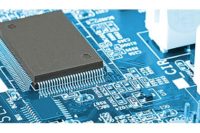LEMONT, IL—In an effort to improve medical isotope production, scientists at Argonne National Laboratory have embarked on a project that harnesses the power of computer-driven robots. The project aims to increase safety and reproducibility, while driving down cost.
For oncologists on the front lines of the battle against cancer, medical radioisotopes represent an indispensable weapon. Their advantage lies in the ability to selectively target malignant tumors with reduced collateral damage to surrounding healthy tissue.
Preliminary research with some radioisotopes has indicated promising advances in cancer treatment. As a result, in many cases the demand for these emerging isotopes is far beyond the available supply. This limits the rate of progress in developing advanced cancer treatments.
Research and production of medical isotopes are currently conducted at national laboratories and university-based accelerators. A handful of private companies are also participating.
Scientists painstakingly create these isotopes by irradiating targets composed of enriched stable isotopes. The desired radioisotopes are created by a nuclear transmutation. However, a significant challenge arises once these radioisotopes are produced in the targets. The small amounts of useful radioisotopes produced need to be chemically separated from the bulk mass of the target material and impurities.
The radiochemical separation can take one of two routes. One is benchtop manual processing in a “glove box,” but this is fraught with radiation exposure to researchers, limiting the throughput of the production batches. The other route involves processing in heavily shielded, dedicated “hot cells.” These cells still use 1940s-era mechanical manipulators. They are maintenance-intensive and expensive and have limited mechanical capability.
The tele-operated robotic system that Argonne plans to develop with the new funding will introduce a new kind of processing station for radioisotopes. It will feature a “hot box” that optimally combines elements of a hot cell and glove box.
An immediate goal is to carry out the basic research required to capitalize on developments in remote or tele-operation. These include new robotics technologies, 3D vision technologies, 3D dynamic modeling with high-speed computing, and cost-effective, capable manipulators that enable complex remote processing.
“Very flexible manipulator capabilities are required to carry out the intricate operations of the radio-chemical separations,” says Millicent Firestone, Argonne deputy associate laboratory director and senior science advisor for Physical Sciences and Engineering.
“Just by gaining the ability to do the manipulation of the sample from across the room means that we can safely handle samples up to 10 times as radioactive without requiring the use of hot cells. This dramatically increases our ability to produce these valuable and necessary isotopes,” says , said Argonne nuclear physicist Jerry Nolen.
The new robotic hot box will operate remotely through augmented reality. The user is seated away from the radioactive sample and uses 3D computer vision and immersive display technologies to visualize the hot box. Also employed will be advanced software to remotely control specially designed robotic components located in the hot box.
Argonne computer scientist Nicola Ferrier said that the technology for the augmented reality is likely to be based on the Omniverse technology developed by the U.S. company Nvidia, paired with optimization of models for real-time interaction. An off-the-shelf headset will give the remote operator a 3D virtual reality view of the interior of the hot box. Omniverse enables the development of 3D workflows using Universal Scene Description (an open standard).
“Precise, real-time visualization of the remote radiochemical processing in the hot box requires a complex 3D workflow that is integrated with the robot system,” she says.



